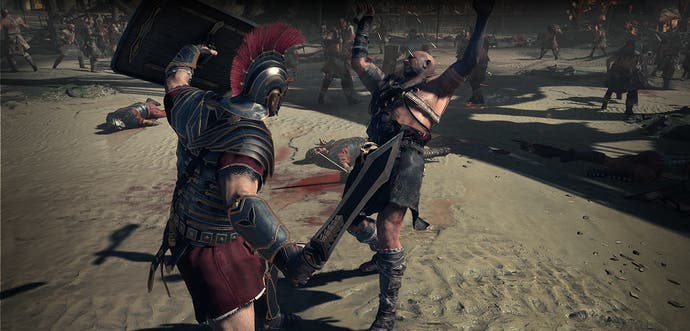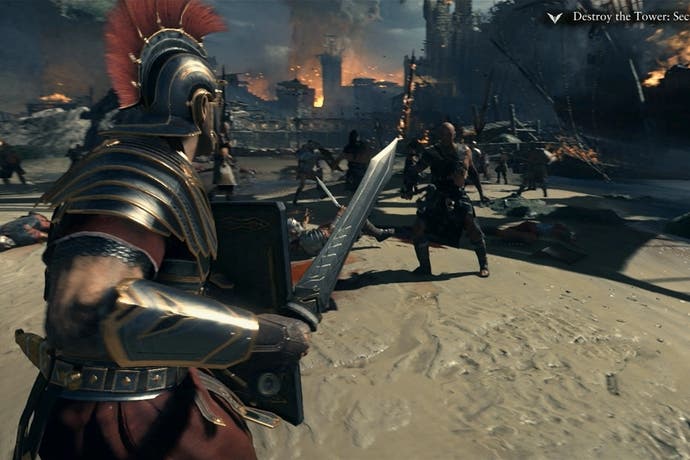Mashing to mastery: is it worth participating in Xbox One exclusive Ryse?
Crytek's hyper-real, ultra-violent brawler brings new meaning to the QTE.
It's just as easy to bash Ryse, Crytek's hyper-real, ultra-violent Roman Empire brawler, as it is to shield bash one of its barbarian enemies with a press of the Y button.
Such is the fleeting nature of any experience with a video game at E3, the industry's annual get together in Los Angeles. Presentations are prepared so explosions pop out of giant screens, key pillars are memorised so press leave with the right message, and development teams tune demos so difficulty is near non-existent.
So, I always try to pull my punches when it comes to casting the hammer blow of judgement down on an E3 demo - particularly if that judgement is a negative one. But in Ryse's case, it's hard to.
The eye-wateringly violent combat has been designed with the key phrase "mashing to mastery" in mind. This key phrase, however sickly sweet, comes from a good place. Indeed Blizzard's long-standing development mantra "easy to learn, difficult to master" is one that's resulted in some of the greatest games of all time.
But let's be honest, using the word "mashing" in the context of a game that at first glance appears to be little more than an unsophisticated collection of quick time events is more likely to but the brakes on the core gamer hype train than give it the boost Microsoft's marketers so desperately wanted out of E3.
And, oddly, sometimes you don't even need to mash the buttons. Ryse's protagonist, the young Roman soldier Marius Titus, is determined to make mince meat out of his enemies whatever the player's mood. If you fail to press the required button in time with the button prompt for one of the game's gory executions, you won't fail. Titus is still a "Roman badass", producer James Goddard tells me, even if the player is not.
Third-person Xbox One exclusive Ryse: Son of Rome was once a first-person Kinect-only game for Xbox 360, but MS approved the switch after developer Crytek pitched three different versions, one of which was a controller-based next-gen title.
Mash the buttons, then, and exciting stuff will just happen. Hammer X for sword slice after sword slice, bash Y for the odd shield attack, sit back, relax, and gawp in wonder as pain etches into your enemy's insanely detailed face. Camera shake, slow motion, that "thuum" of audio made cool by The Matrix: it's all there in the video game version of TV's Spartacus.
This experience, this easy-going blood bath, is for those who just want to f*** s*** up after a hard day's work. They don't want the frustration of death or the annoyance of having to repeat a QTE after a mistimed flash of X. They want to feel ultra powerful. They want to live the power fantasy of the Roman badass. And to those people, I say: fair enough. Go for your life.
But what about those who don't mind the odd bout of frustration? What about those who like to earn the power fantasy of the Roman badass? What about me?
This is, according to Microsoft's producers, where the "mastery" comes in. Ryse's combat is based on timing and it rewards you for nailing it. Back to that execution button prompt: press the appropriate button with "Legendary Timing" - that is, within the first couple of frames of the on screen message's appearance - and you'll be rewarded with whatever perk is associated with that execution. It might be a combo multiplier, extra experience points or even some health points. Oh, and you'll get even more violent visuals - a more dramatic camera shake, slower slow mo, bloodier blood spurts. You might even leave your sword in your opponent's neck just a little bit longer.
The first time you use your shield to deflect an enemy enemy blow you might fluff the timing. The second time, you might do the same. But master it and you'll spin your opponent around, increasing the window of opportunity to follow up with an attack.
There are elements of strategy buried deep beneath Ryse's casual veneer. Its progression system sees you unlock these execution moves over time, and you set the associated perks. There were eight executions in the E3 demo, but the final game will have over 100, so it'll take some time to learn all the animations to a point where you can combo attacks without much fuss. Eventually, as the executions and the animation blends become more familiar, you enter a strange kind of numb fighting zone, and you cut through the scores of barbarian bandits as effortlessly as Gerard Butler slices and dices poor Xerxes' minions in Zack Snyder's equally hyper-real action flick 300. Mashing is fine, but mastery gives you benefits.
"You don't have to do anything," Microsoft producer James Goddard, a video game combat specialist who is consulting on the project, tells me. "You'll just kill the guy because you're a Roman badass. Do you get your perk stuff? No. You didn't participate."
Really, then, Ryse is unlike any QTE game I've ever played. The QTEs don't risk failure, rather, they present an opportunity to do better. They're like in-game hints, flashing on-screen promises of increasingly cinematic (brutal) Roman combat. Ryse is a game where good timing makes a handful of barbarians as threatening as a gaggle of puppies, each wearing spiky collars.
Ryse is an Xbox One launch title from Crytek, maker of Crysis. They like replacing Is with Ys.

It's a glossy experience, but is it a bad one? I was apathetic about Ryse after playing its E3 demo. Its combat is more inconsequential than offensive. I get why it's an Xbox One launch title. It ticks all the right next-gen boxes for Microsoft. It uses the new Kinect in an add-on kind of way: you can bark orders to your fellow soldiers in "leadership" encounters, such as taking a catapult or shuffling into defensive formations, and you can call in arrow strikes, which is their actual name (Ryse is Call of Duty with swords and shields instead of guns) by shouting at your telly instead of pressing buttons on the controller.
There's Smartglass integration in the form of a real-time strategy guide, which gives you hints as you play (not that you'll need them) for that essential second screen experience. And the up close and personal, "six inches to six feet" CryEngine 3-fuelled graphics are technically striking. Microsoft's producers say the number of AI-controlled soldiers running about on screen at once wouldn't have been possible on the Xbox 360. If you see a Roman soldier trading blows with a barbarian in the distance somewhere, you can run over to them and interrupt their rendezvous with sword strikes of your own.
Hammering home the point that Ryse in its current form wouldn't be possible on current generation hardware, Microsoft producers say silly things like, "the smoke billowing from the distant tower requires as much memory as the Xbox 360 has", and, "Titus' eyeball includes more technology as an entire character in an Xbox 360 game".
But for all Ryse's bells and whistles, the experience of playing it washes over you rather than seeps into your skin. What you're left with is a flashy but basic brawler that benefits from a twist of strategy and a dash of skill. The fuss over the quick time events is a red herring, I reckon. Ryse's combat gets better the more you play along. I just don't think I can be bothered to participate.










